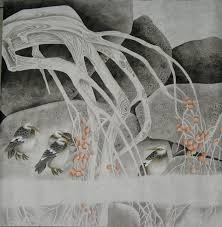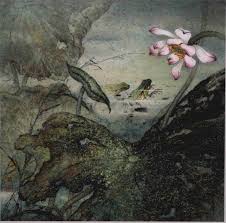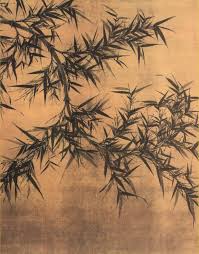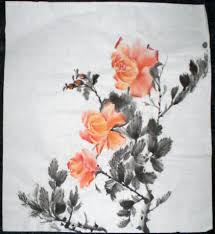Source:- Google.com.pk
Chinese Paintings Biography
Qi Baishi (simplified Chinese: 齐白石; traditional Chinese: 齊白石; pinyin: Qí Báishí; Wade–Giles: Ch'i Pai-shih) (January 1, 1864 – September 16, 1957) was an influential Chinese painter.
Born to a peasant family from Xiangtan, Hunan, Qi became a carpenter at 14, and learned to paint by himself. After he turned 40, he traveled, visiting various scenic spots in China. After 1917 he settled in Beijing.
He is perhaps the most noted for the whimsical, often playful style of his watercolor works.
Some of Qi's major influences include the early Qing Dynasty painter Bada Shanren (八大山人 or Zhu Da) and the Ming Dynasty artist Xu Wei (徐渭).
His pseudonyms include Qí Huáng (齊璜) and Qí Wèiqīng (齐渭清). The subjects of his paintings include almost everything, commonly animals, scenery, figures, toys, vegetables, and so on. He theorized that "paintings must be something between likeness and unlikeness, much like today's vulgarians, but not like to cheat popular people". In his later years, many of his works depict mice, shrimp, or birds.
He was also good at seal carving and called himself "the fortune of three hundred stone seals".
In 1953 he was elected to the president of the Association of Chinese Artists. He died in Beijing in 1957. One of his paintings, Eagle Standing on Pine Tree, was sold for 425.5 million yuan ($65.5 million) in 2011, becoming one of the most expensive paintings ever sold at auction.[1]
Contents [hide]
1 Early life
2 Training and education
3 Settling down
4 Personal experiences
5 See also
6 Notes
7 References
8 External links
[edit]Early life
Monument to Qi Baishi in the park named after him
He was born in Xiangtan Hunan and grew up in a family of low-income background. He lived with his parents, grandparents, and eight younger sisters and brothers. Qi Baishi was schooled for less than a year due to illness. However, he was too weak do much of the work and this was when he became a carpenter. While Qi Baishi was growing up, he came upon a Chinese manual of painting, this was what sparked his interest in art and painting animals,bugs and other types. In his painting, depict things that people have seen however, he didn’t start following this motto until much later in his life. He first studied the "Manual of the Mustard Seed Garden" (芥子園畫傳) and used performers, mainly opera, for models to practice his work. After using opera performers as models Qi Baishi turned to anyone he knew to pose for him and Baishi has lots of painting throughout his life and he became one of the best painters in China and he painted with oil paste and paint
[edit]Training and education
“Qi Baishi started receiving artistic training from Hu Qinyuan which consisted of fundamentals in gongbi mode, which features fine brushwork and meticulous detail” (Jung Ying Tsao p. 199). He was taught that every aspect of painting mattered, from the subject matter to the way the paint was applied to the paper. His landscape paintings came as a result of his next mentor Tan Pu. Because of his training, he then realized that he could peruse art as his full time career instead of just dreaming to become a professional artist (Jung Ying Tsao p. 199-201).
Baishi was popular for his variety of works ranging from plant to animal life; because of his natural style collectors both “artistic and political” purchased his work. According to the article, Qi Baishi [Ch’i Pai-shih; zi Huang; hao Baishi Laoren, Baishi Shanqeng]: "Baishi’s works were based on his life and his character. After the fall of the Qing dynasty Qi Baishi was known for not letting all the political issues affect his work, and keeping his own values and ideas through the harsh times. According to Confucian standards, starting off as nothing and creating a name for yourself, as Baishi did, was very honorable (Xiangtan p. 1).
Qi Baishi didn’t have any formal education or training in the field of art; however, he managed to master many different techniques including calligraphy and seal-carving. After establishing himself in Hunan, as a painter and artist, it wasn’t until his forties that he began traveling and looking for more inspiration. Baishi came upon the Shanghai School, which was very popular at the time, and met Wu Changshuo who then became another mentor to him and inspired a lot of Baishi’s works. Another influence of Baishi didn’t come until about fifteen years later who was Chen Shizeng who he became close to when he was living in Beijing. Baishi was becoming more and more well-known and sought after. During World War II, many traditional art works and culture were being destroyed and no longer things of value, but Baishi was still respected and was “elected to the National People’s Congress and made honorary Chairman of the National Artist’s’ Association, he represented a continuing commitment to traditional cultural values in revolutionary China” (Xiangtan, p. 1). He died at age 93.
[edit]Settling down
After all of Baishi’s travels he built a house and settled down. He began reading and writing poetry and painting from some of the mountains he saw while he was traveling. The paintings that were a result of this became a series of fifty landscape pictures known as “Chieh-shan t’u-chuan.” Later, these paintings got poems and postscripts printed on them from artists that Baishi knew (Boorman & Howard p. 302-304). One of Baishi’s earlier series of works that was called “The Carp” was noticed and praised because of the simple style that contained no excess decorations or writings. His work was also praised because of his noticeable talent with wood-carving and all of his personal influences expressed on and threw this work. It wasn’t until Baishi was in his mid-fifties that he was considered a mature painter. As a mature painter, his lines were sharper and the subject matter changed from an animal-life base to a more plant life base in his works of art. As said by Wang Chao-Wen, “he based his work on reality while experimenting ceaselessly in new ways of expression, to integrate truth and beauty, create something yet unimagined by other artists, and achieve his own unique style, on that should not be artificial” (p. 127).
[edit]Personal experiences
Wang Chao-Wen said that while Baishi was talking to a student in Peking he saw an outline of a bird on a brick floor in muddy water. He goes on to say that not everyone would have seen the bird, and that it was because Baishi was always concerned with finding new images to paint that he had a “special sensitivity” (p. 129). It was said that Baishi had something special about him because he was constantly thinking about painting and had such a strong drive and motivation to be a great artist. (Chao-Wen p. 90698)
Some excerpts from Qi Baishi’s journal were found that represent his strong drive and passion for his work, not to mention his high confidence in his speciality. From the article “An Appreciation of Chi Pai-Shi’s Paintings,” (Baishi was previously known as Chi Pai-Shi) his journal entry reads as follows:
“When I cut seals I do not abide by the old rules, and so I am accused of unorthodoxy. But I pity this generation’s stupidity, for they do not seem to realize that the Chin and Han artists were human and so are we, and we may have our unique qualities too… Such classical artists as Ching-teng, Hsueh-ko and Ta-ti-tzu dared to make bold strokes in their paintings, for which I admire them tremendously. My one regret is that I was not born three hundred years ago, for then I could have asked to grind ink or hold the paper for those gentleman, and if they would not have me I should have starved outside their doors rather than move away. How wonderful that would have been! I suppose future generations will admire our present artists just as much as we admire these men of old. What a pity that I will not be there to see it!” (Wang Chao-Wen p. 130-131)
From this excerpt it is evident that Qi Baishi was serious about his work. Because of Baishi’s talk about wanting to be human it was clear that he was educated about the times and the political issues that were going on while he was making his art work, which is powerful because he never took any political stance in any of his art works. This except also shows how passionate he was about other artists and how much he would want to be mentored by them.
What is unique about Baishi is that his works show no western influences, unlike most other artists at this time. Other artists praised Baishi for his “freshness and spontaneity that he brought to the familiar genres of birds and flowers, insects and grasses, hermit-scholars and landscapes” (Xiangtan, p. 2). Even though Baishi wasn’t the first artist to focus on small things in nature, he was recognized for his very careful and beautiful way of painting such common images.








Chinese Paintings Biography
Qi Baishi (simplified Chinese: 齐白石; traditional Chinese: 齊白石; pinyin: Qí Báishí; Wade–Giles: Ch'i Pai-shih) (January 1, 1864 – September 16, 1957) was an influential Chinese painter.
Born to a peasant family from Xiangtan, Hunan, Qi became a carpenter at 14, and learned to paint by himself. After he turned 40, he traveled, visiting various scenic spots in China. After 1917 he settled in Beijing.
He is perhaps the most noted for the whimsical, often playful style of his watercolor works.
Some of Qi's major influences include the early Qing Dynasty painter Bada Shanren (八大山人 or Zhu Da) and the Ming Dynasty artist Xu Wei (徐渭).
His pseudonyms include Qí Huáng (齊璜) and Qí Wèiqīng (齐渭清). The subjects of his paintings include almost everything, commonly animals, scenery, figures, toys, vegetables, and so on. He theorized that "paintings must be something between likeness and unlikeness, much like today's vulgarians, but not like to cheat popular people". In his later years, many of his works depict mice, shrimp, or birds.
He was also good at seal carving and called himself "the fortune of three hundred stone seals".
In 1953 he was elected to the president of the Association of Chinese Artists. He died in Beijing in 1957. One of his paintings, Eagle Standing on Pine Tree, was sold for 425.5 million yuan ($65.5 million) in 2011, becoming one of the most expensive paintings ever sold at auction.[1]
Contents [hide]
1 Early life
2 Training and education
3 Settling down
4 Personal experiences
5 See also
6 Notes
7 References
8 External links
[edit]Early life
Monument to Qi Baishi in the park named after him
He was born in Xiangtan Hunan and grew up in a family of low-income background. He lived with his parents, grandparents, and eight younger sisters and brothers. Qi Baishi was schooled for less than a year due to illness. However, he was too weak do much of the work and this was when he became a carpenter. While Qi Baishi was growing up, he came upon a Chinese manual of painting, this was what sparked his interest in art and painting animals,bugs and other types. In his painting, depict things that people have seen however, he didn’t start following this motto until much later in his life. He first studied the "Manual of the Mustard Seed Garden" (芥子園畫傳) and used performers, mainly opera, for models to practice his work. After using opera performers as models Qi Baishi turned to anyone he knew to pose for him and Baishi has lots of painting throughout his life and he became one of the best painters in China and he painted with oil paste and paint
[edit]Training and education
“Qi Baishi started receiving artistic training from Hu Qinyuan which consisted of fundamentals in gongbi mode, which features fine brushwork and meticulous detail” (Jung Ying Tsao p. 199). He was taught that every aspect of painting mattered, from the subject matter to the way the paint was applied to the paper. His landscape paintings came as a result of his next mentor Tan Pu. Because of his training, he then realized that he could peruse art as his full time career instead of just dreaming to become a professional artist (Jung Ying Tsao p. 199-201).
Baishi was popular for his variety of works ranging from plant to animal life; because of his natural style collectors both “artistic and political” purchased his work. According to the article, Qi Baishi [Ch’i Pai-shih; zi Huang; hao Baishi Laoren, Baishi Shanqeng]: "Baishi’s works were based on his life and his character. After the fall of the Qing dynasty Qi Baishi was known for not letting all the political issues affect his work, and keeping his own values and ideas through the harsh times. According to Confucian standards, starting off as nothing and creating a name for yourself, as Baishi did, was very honorable (Xiangtan p. 1).
Qi Baishi didn’t have any formal education or training in the field of art; however, he managed to master many different techniques including calligraphy and seal-carving. After establishing himself in Hunan, as a painter and artist, it wasn’t until his forties that he began traveling and looking for more inspiration. Baishi came upon the Shanghai School, which was very popular at the time, and met Wu Changshuo who then became another mentor to him and inspired a lot of Baishi’s works. Another influence of Baishi didn’t come until about fifteen years later who was Chen Shizeng who he became close to when he was living in Beijing. Baishi was becoming more and more well-known and sought after. During World War II, many traditional art works and culture were being destroyed and no longer things of value, but Baishi was still respected and was “elected to the National People’s Congress and made honorary Chairman of the National Artist’s’ Association, he represented a continuing commitment to traditional cultural values in revolutionary China” (Xiangtan, p. 1). He died at age 93.
[edit]Settling down
After all of Baishi’s travels he built a house and settled down. He began reading and writing poetry and painting from some of the mountains he saw while he was traveling. The paintings that were a result of this became a series of fifty landscape pictures known as “Chieh-shan t’u-chuan.” Later, these paintings got poems and postscripts printed on them from artists that Baishi knew (Boorman & Howard p. 302-304). One of Baishi’s earlier series of works that was called “The Carp” was noticed and praised because of the simple style that contained no excess decorations or writings. His work was also praised because of his noticeable talent with wood-carving and all of his personal influences expressed on and threw this work. It wasn’t until Baishi was in his mid-fifties that he was considered a mature painter. As a mature painter, his lines were sharper and the subject matter changed from an animal-life base to a more plant life base in his works of art. As said by Wang Chao-Wen, “he based his work on reality while experimenting ceaselessly in new ways of expression, to integrate truth and beauty, create something yet unimagined by other artists, and achieve his own unique style, on that should not be artificial” (p. 127).
[edit]Personal experiences
Wang Chao-Wen said that while Baishi was talking to a student in Peking he saw an outline of a bird on a brick floor in muddy water. He goes on to say that not everyone would have seen the bird, and that it was because Baishi was always concerned with finding new images to paint that he had a “special sensitivity” (p. 129). It was said that Baishi had something special about him because he was constantly thinking about painting and had such a strong drive and motivation to be a great artist. (Chao-Wen p. 90698)
Some excerpts from Qi Baishi’s journal were found that represent his strong drive and passion for his work, not to mention his high confidence in his speciality. From the article “An Appreciation of Chi Pai-Shi’s Paintings,” (Baishi was previously known as Chi Pai-Shi) his journal entry reads as follows:
“When I cut seals I do not abide by the old rules, and so I am accused of unorthodoxy. But I pity this generation’s stupidity, for they do not seem to realize that the Chin and Han artists were human and so are we, and we may have our unique qualities too… Such classical artists as Ching-teng, Hsueh-ko and Ta-ti-tzu dared to make bold strokes in their paintings, for which I admire them tremendously. My one regret is that I was not born three hundred years ago, for then I could have asked to grind ink or hold the paper for those gentleman, and if they would not have me I should have starved outside their doors rather than move away. How wonderful that would have been! I suppose future generations will admire our present artists just as much as we admire these men of old. What a pity that I will not be there to see it!” (Wang Chao-Wen p. 130-131)
From this excerpt it is evident that Qi Baishi was serious about his work. Because of Baishi’s talk about wanting to be human it was clear that he was educated about the times and the political issues that were going on while he was making his art work, which is powerful because he never took any political stance in any of his art works. This except also shows how passionate he was about other artists and how much he would want to be mentored by them.
What is unique about Baishi is that his works show no western influences, unlike most other artists at this time. Other artists praised Baishi for his “freshness and spontaneity that he brought to the familiar genres of birds and flowers, insects and grasses, hermit-scholars and landscapes” (Xiangtan, p. 2). Even though Baishi wasn’t the first artist to focus on small things in nature, he was recognized for his very careful and beautiful way of painting such common images.
Chinese Paintings
Chinese Paintings
Chinese Paintings
Chinese Paintings
Chinese Paintings
Chinese Paintings
Chinese Paintings
Chinese Paintings
Chinese Paintings
Demystify Chinese Painting
Traditional Chinese Painting Techniques
No comments:
Post a Comment